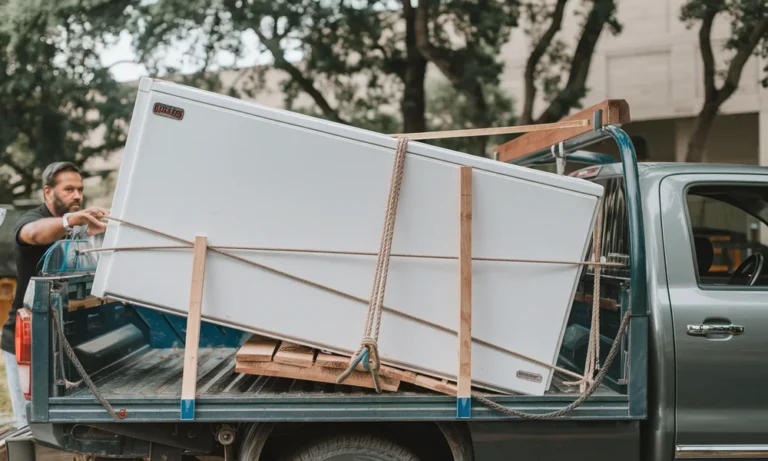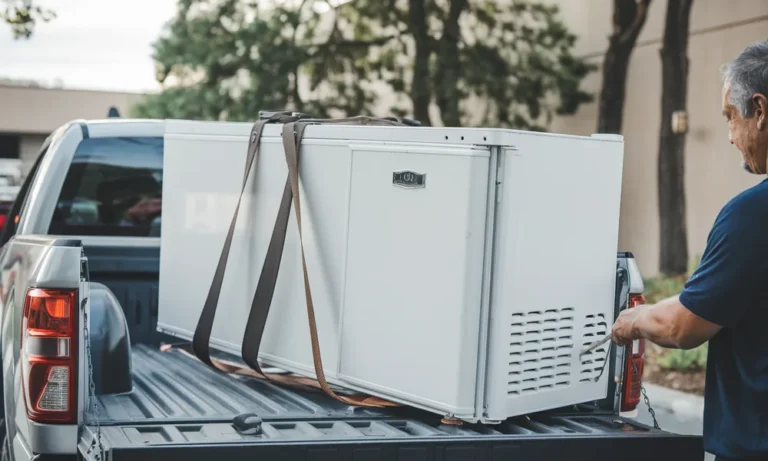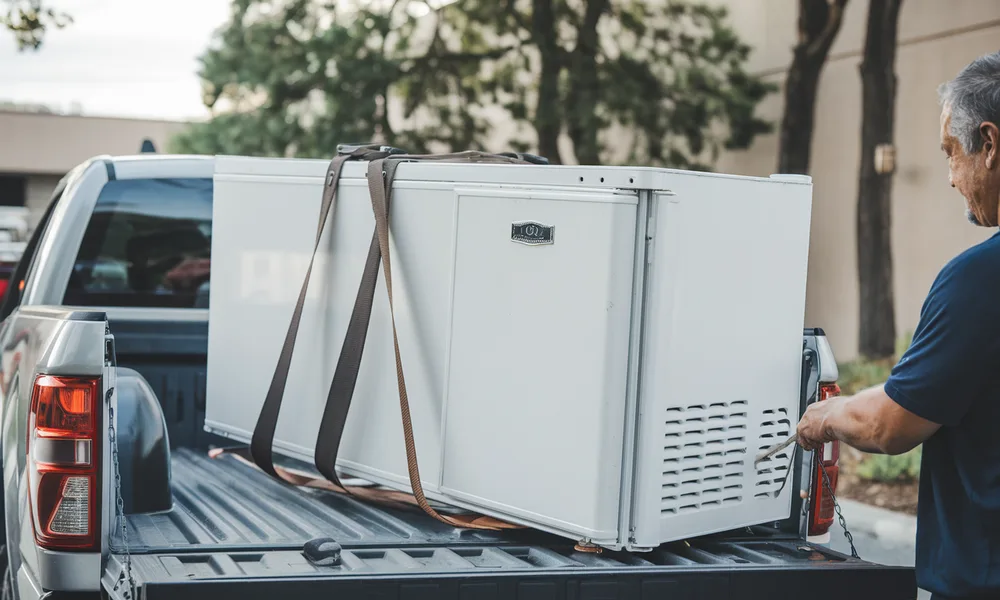How to transport a refrigerator in a pickup requires careful planning to avoid damage. The size and weight of the fridge make it challenging to load, and improper handling could lead to internal issues. To ensure a smooth move, it’s important to unplug the refrigerator, secure the door, and clean and dry it before loading. When considering how to load fridge in truck, using proper equipment like moving straps or a dolly is crucial for lifting and positioning the appliance. Loading refrigerator in truck should be done carefully, ensuring it stays upright to prevent fluid damage. A pickup truck can be an ideal solution for transportation when prepared correctly, reducing the risk of harm during the move.
How to Move a Refrigerator

Moving a refrigerator can be a challenge, but with the right planning and tools, it can be done safely. Here are some key considerations to keep in mind when moving a fridge:
1. Measure the Refrigerator and Truck Bed
Measure the refrigerator and the pickup truck bed before you begin. This guarantees that the refrigerator will fit into the truck and through doorways. Refrigerators come in different sizes, so it’s important to know the exact dimensions to avoid any surprises.
2. Consider the Weight and Size
Refrigerators can weigh anywhere from 150 to 400 pounds. Moving one requires careful handling, especially when using a dolly or hand truck. Make sure you have help and avoid tilting the fridge to prevent damage to sensitive parts.
3. Essential Tools and Equipment
- Dolly (Hand Truck): Use a heavy-duty dolly to roll the fridge easily across flat surfaces.
- Straps: To keep the refrigerator steady while being transported, fasten it using straps.
- Blankets: Cover the refrigerator with blankets to prevent scratches on the truck bed and refrigerator.
- Pickup Truck: When it comes to moving big refrigerators, a pickup truck refrigerator configuration is ideal. Use a ramp to load the refrigerator and make sure the truck bed is big enough.
Steps for Moving a Refrigerator:
- Prepare the Fridge:If required, empty the refrigerator, disconnect it, and allow it to defrost.
- Wrap and Secure: Secure the refrigerator with straps on the dolly after wrapping it in blankets.
- Load into the Truck: Secure the refrigerator with straps after loading it onto the truck bed using a ramp.
- Drive Carefully: Keep the fridge upright and drive slowly to prevent shifting.
You can contact us for moving services in Los Angeles.
Can You Lay Down a Refrigerator?
While it might seem easier to lay a refrigerator down during transport, it’s generally not recommended due to several risks. Here’s why you should avoid laying it down and what you can do instead.
Risks of Laying a Refrigerator Down
A refrigerator can sustain serious damage if it is placed on its side or back. Here are the main risks:
- Oil and Gas Leakage: Refrigerators rely on a compressor and refrigeration system that contains oil and gas. Laying the fridge down can cause the oil to move out of the compressor and into the refrigerant lines, leading to potential leaks or system failure.
- Compressor Damage: One of the refrigerator’s more vulnerable parts is the compressor. When the fridge is laid down, it can put unnecessary strain on the compressor, which may cause it to malfunction or break.
Alternatives to Laying It Down
If you need to transport a refrigerator, here are safer options:
- Keep the Fridge Upright: A refrigerator is best moved while it is standing upright. Loading the refrigerator in a truck upright minimizes the risks associated with oil and gas leakage, as well as protecting the compressor.
- Properly Fastening the Fridge: To keep a strapped refrigerator from toppling over or shifting while being transported, fasten it to both the truck and the dolly. Ensure that it is stable and upright in the truck bed, with plenty of padding to avoid scratches.
How to Transport a Refrigerator in a Pickup Truck | Easy Steps

Transporting a refrigerator in a pickup truck can be done safely with the right preparation and equipment. Follow these step-by-step instructions to ensure your fridge arrives in one piece.
1. Preparation: Disconnecting the Fridge and Removing Shelves
Make sure your refrigerator is fully unplugged from all power sources before you begin strapping it up or placing it onto the truck. Unplug the fridge and let it sit for at least 30 minutes to an hour to allow the coolant to settle. After that, take out the refrigerator’s shelves, trays, and other contents to keep them from shifting or shattering while being transported.
2. Positioning the Pickup Truck
Ensure the pickup truck refrigerator area (the truck bed) is clean and free of debris.Both the vehicle and the refrigerator are less likely to sustain scratches or other damage when the bed is kept clean. Lay down a moving blanket or protective cover in the truck bed to cushion the fridge.
3. Lifting the Refrigerator
When learning how to load a fridge in a truck, it’s crucial to have the right technique.Lift and roll the refrigerator into the vehicle using a dolly. If you don’t have a dolly, enlist the help of a second person to lift the fridge safely. To prevent injury, always lift with your legs and never twist your back.
4. Securing the Refrigerator
It’s time to fasten the refrigerator after it’s in the truck bed. Straps are necessary while moving a refrigerator to prevent it from shifting or falling while being transported. Secure the refrigerator firmly in position with sturdy moving straps. Use additional blankets to shield it from dings and scrapes. To avoid the coolant moving incorrectly when traveling, make sure the refrigerator is upright.
5. Transporting the Refrigerator
Take extra care to drive smoothly when you’re ready to get behind the wheel. Avoid sharp turns, sudden stops, or fast accelerations to prevent the fridge from moving or tipping over. Keep an eye on your load during transit to ensure everything stays in place.
6. Unloading the Refrigerator
Once you’ve reached your destination, carefully unload the refrigerator from the truck. If possible, have someone assist you in lifting it out of the truck and positioning it in its new location. Be cautious when maneuvering the fridge into tight spaces or doorways to avoid damage to the appliance or surroundings.
For packing services in Los Angeles, contact Chamomile Go.
Common Mistakes to Avoid
When transporting a refrigerator in a pickup truck, there are a few common mistakes that can lead to damage or complications during the move. Avoid these mistakes to ensure your fridge is safely and securely moved.
1. Laying the Refrigerator Flat
One of the biggest mistakes when moving a refrigerator with straps is laying the appliance flat. Always keep the refrigerator upright during transport. Laying it on its side can cause the compressor oil to flow into the coolant lines, which could damage the appliance and affect its functionality. Ensure that the fridge is securely positioned and upright in the truck bed to prevent any damage.
2. Overloading the Pickup Truck or Improperly Securing the Appliance
Another mistake is overloading the pickup truck or failing to properly secure the refrigerator. When moving a refrigerator with straps, it’s essential to use heavy-duty, quality straps to secure the fridge in place. If the fridge isn’t properly fastened, it could shift or even fall during transit, potentially damaging the appliance or causing an accident. Be sure not to overload the truck, as too much weight can strain the vehicle and compromise safety.
3. Forgetting to Defrost or Clean the Fridge Before Moving
Before transporting your refrigerator, always remember to defrost it and clean it thoroughly. Leaving water or moisture inside can cause mold growth or unpleasant odors during the move. Additionally, any remaining food or liquids can spill and cause a mess. Taking the time to properly clean and dry the fridge will ensure a smoother move and protect it from damage.
Conclusion
Transporting a refrigerator in a pickup truck can be a straightforward process if you follow the right steps. From preparing the fridge, securing it with straps, and ensuring smooth driving, these simple tips can prevent damage and make your move hassle-free. If you’re unsure about how to load a fridge in a truck or need assistance with the entire moving process, Chamomile Go is here to help. Whether you’re in need of moving and packing services in Los Angeles or require professional advice, our experienced team is ready to assist. Don’t risk damaging your fridge or dealing with the stress of moving on your own. Contact us today and let us take care of your transport needs with care and efficiency. Call us now or visit our website to get a free quote!
FAQs
What Is The Best Way To Load A Refrigerator Into A Pickup Truck?
The best way to load a refrigerator into a pickup truck is to use a dolly for easier lifting, ideally with the help of a second person. Once the fridge is upright and in the truck bed, secure it with heavy-duty straps to prevent it from shifting during transit. Always ensure the fridge is positioned upright to avoid damage.
Can I Lay My Refrigerator Flat In The Truck For Transport?
No, it’s not recommended to lay your refrigerator flat during transport. Laying the fridge on its side can cause the compressor oil to flow into the coolant lines, potentially damaging the appliance. Always keep the refrigerator upright to maintain its functionality.
How Do I Secure The Refrigerator In The Truck Bed?
To secure your refrigerator, use heavy-duty moving straps to tightly fasten it to the sides of the truck bed. Additionally, you can use blankets or padding to protect the fridge from scratches. Make sure the fridge is stable and doesn’t shift during transport.
Do I Need To Disconnect The Refrigerator Before Moving It?
Yes, before transporting your refrigerator, always unplug it to ensure it’s safely disconnected from the power source. It’s also advisable to let the fridge sit unplugged for 30 minutes to an hour to allow the coolant to settle.
Should I Clean And Defrost The Refrigerator Before Transporting It?
Yes, you should always defrost and clean your refrigerator before moving it. Remove all items inside, including shelves and trays, and thoroughly clean and dry the interior. This will prevent any spills or mold growth and make the move much easier.








